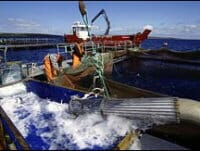 |
| Fish handling and transport is poorly supported by scientific research. |
"There appears to be a lack of standardisation where guidance on environmental conditions is concerned. Factors such as densities, water quality limits, temperatures and journey times differ across the industry and where guidelines are available, it is unclear as to how they were derived," he explained.
Fitness and welfare, in relation to transport are vital parameters, yet in most cases the methods for assessment, and their interpretation are vague - and mostly dependent upon the individual operator. As a result, many operators are working to their own limits - borne from experience and adapted to suit the specifications of the journey, season, species and size and growth stage of the fish being handled.
Key areas
CEFAS and the Humane Slaughter Association have noted some key areas for investigation and further development. Both organisations believe more research is needed. And a good start would be to improve communication to producers, hauliers and processors. The welfare of fish in transport will become increasingly important as the industry expands and forges stronger links with retailers an consumers. Also, farmers and allied trades need to understand of how welfare in transit can impact on business productivity and so profits.
More than shipping
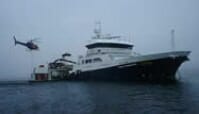 |
| Transport of fish involves far more than just shipment - numerous stages need to be considered. |
Transport of fish involves far more than just shipment - numerous stages need to be considered including the handling/grading systems, feed withdrawal periods, crowding at loading, loading and unloading procedures and transport within a tank, well or bucket. The introduction and acclimatisation of fish to their new environment is also vitally important.
There are numerous interactions between water quality parameters such as oxygen, salinity, pH, carbon dioxide, ammonia, hardness, nitrite, suspended solids, temperature. These elements all have a significant impact on the fish. For example, consider ammonia concentration. In a typical Scottish loch (water temp.10°C, pH 6.5) the total ammonia concentration is about 3 mg/L, and only 0.0018 mg/L would be as the toxic unionised form (NH3). Compare this with a typical English chalk fed river (water temp.15°C, pH 7.8) where the same amount of total ammonia would harbour 20 times as much of the toxic form.
These parameters must be considered when relocating fish stocks. Transportation is stressful, but introduction to a new environment could be equally, if not more distressing.
Water: The principle element
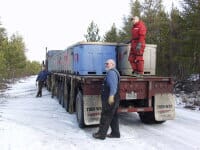 |
| During transit fish experience a very alien environment to that of a pond or rearing cage in open water. |
The key to good transport is water quality, and primarily oxygen levels.
The rate at which water quality deteriorates will determine the duration of a journey or the number of fish transported at any one time. This obviously has cost implications too, and the balance between economics and welfare can be very delicate. The closed nature of the tanks used in when transporting fish does incur water quality problems, and technology to tackle faecal and mucus contamination, as used by recirculation aquaculture, is now being applied to transport systems. Tables are available prescribing recommended limits for numerous water quality parameters. However, many scientists feel this is far too simplistic. For example, the impact of suspended solids on fish health depends on the specifics of the particle size, shape and material, rather than just the concentration.
Despite the lack of qualified information on the response of fish inside transport tanks, it is nevertheless assumed that transport itself causes stress, fear and physical damage.
During transit fish are exposed to physical stimuli such as lights, noise, vibration, sudden water movements, and possibly rapid altitude changes - a very alien environment to that of a pond or rearing cage in open water.
Scientific perceptions
At the forum Craig MacIntyre, Scientist at the University of Stirling said that defining welfare was very difficult. In simple terms, the interpretation of welfare could be broken down into three areas:
- Function-based: reflecting the ability of the animal to perform in the farm environment.
- Feelings-based: reflecting whether the animal has what it wants and how it feels.
- Nature-based: reflecting whether the animal can express its natural behaviour
However, he noted that different interest groups may not see welfare in the same way.
"A function-based view is adopted by many scientists, as it allows the relatively straightforward measurement of parameters representing health and condition, for example stress hormones and condition factor. A feelings-based view assumes that animals have mental experiences and that we can interpret these. Preference testing and behaviour are being used, but such methods are difficult to apply under farm conditions and during transport," he explained.
But he questioned the nature-based view - an ideal that is supported by animal rights groups, but is very difficult to quantify.
Mr MacIntyre said that there was currently no evidence to determine if fish have a conscious experience of events or circumstances or their 'emotional capacity' to suffer. However, he felt that welfare requirements for fish would ultimately be determined by society - through consumers and retailers and what they deemed acceptable.
Duty bound
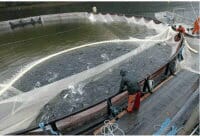 |
| Harvesting, loading and transport are stressful procedures and unfit fish do not cope well. |
A clearly defined duty of care is being placed on farmers, transporters and processors, and that was no bad thing for the industry or its customers.
Under the Welfare of Animals (Transport) Order 1997 (WATO) it is a legal requirement that all animals must be fit to travel before they embark on any journey. These regulations have been incorporated into many welfare schemes such as the RSPCA Freedom Food initiative, and are practiced for a variety of reasons, said Pete Southgate of the Fish Vet Group.
"Loading and transport are stressful procedures and unfit fish do not cope well with the high concentration of fish in transport tanks. It also facilitates the transmission of any infection as transport presents a high risk of breaching biosecurity and introduction of disease to the destination," he explained.
Both stockpeople and transporters have some measure of responsibility when assessing fitness to travel. Visual observations should carried out by a competent person a few days before transit.
Stockmen need to monitor behaviour, the presence of moribund and dead fish, the condition of the fins and body, the presence of lesions and/or any damage and Investigation for external skin and gill parasites can also be included. Any unfit individuals should be removed, and if necessary the movement of suspect populations postponed pending further examination.
Visual inspections may be more difficult in sea cages, but can be done using a cameras or divers. And an assessment of recent disease history using veterinary reports, treatment records and mortality figures is also advisable.
"If there has been a recent disease outbreak, then the risk of residual infection or fish acting as carriers, should also be considered. The fish should also be observed during the crowd prior to loading, when sick or dead individuals can be removed," said Mr Southgate.
In practice, he recommends a checklist of all observations and conclusions is used to assess fish fitness for travel. This could also provide some level of certification in case of inspection.
Future moves
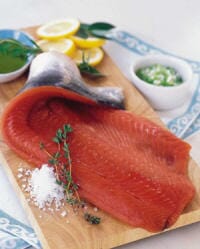 |
| Consumers are increasingly interest in how farmed fish produced. |
Defra representative Chris Elmer gave an insight into new regulations and the implication it has for fish farming. A new Welfare of Animals (Transport) Order came into force in January this year. It covers the protection of animals during transport including all vertebrates in connection with any economic activity. The transport of fish in relation to food, sporting, ornamental, display aquaria, and research activities all fall under the regulations. The law now states that:
- No person shall transport or cause animals to be transported in a way likely to cause injury or undue suffering
- The fish are fit for transport and must be transported in accordance with any written instructions about feeding and watering, and any special care required is taken into account
- The means of transport is designed, constructed, maintained and operated so as to avoid injury and suffering, and provides protection from extreme temperatures.
The new order also requires that road vehicles used to transport livestock for over eight hours are inspected and issued with an approval certificate. However, fish transport vehicles are believed to be exempt from this requirement, as fish tanks are not considered to be an integral part of the vehicle.
Even so, a new requirement means that transporter authorisation will be required for anyone transporting fish more than 65Km. Such journeys will require: the transporter to have had no serious breaches of animal welfare legislation; to be trained or entrusted in the handling of the animals to personnel who have received training; to demonstrate that they have appropriate staff and equipment to transport animals in an proper way. In this case authorisation can be issued free of charge (if applied for within this financial year), and will be valid for five years.
Mr Elmer said that it was difficult to relate the new regulations to wellboats and/or helicopters because the legislation was primarily drafted for the transport of farm livestock, horses and poultry.
In essence, the new rules required little change for most fish transport, other than the need to apply for an authorisation. He said that more conditions specific to fish handling and transport were likely in the future. The European Food Standards Authority made recommendations on transport of fish way back in March 2004. They covered loading, transport management, space allowances, water temperatures, oxygen availability, and recovery after transport. Mr Elmer said that these recommendations could well be adopted by the Commission in future, but are not expected before 2011.
Practical value
"The fish are transported in a variety of ways depending upon their growth stage. At the freshwater stage they are moved in trucks and contracted helicopters, and smolts and harvest fish are transported in wellboats. All fish are inspected four weeks prior to transportation and gain at loading," he explained.
Transport involves feed withdrawal, physical handling and keeping fish in a modified environment during transport. The principle aim is to provide a safe environment and minimise unnecessary stress to the fish before, during and after transport.
The fish are monitored for up to 30 days post-transit and observations are recorded to identify any effects of the transport. The information is fed back into the overall risk assessment calculations which is carried out for every consignment, revised and communicated to all relevant personnel.
Mr Barrington advocates risk assessments at every stage - he said it was a vital means of optimising fish welfare and business efficiency.
SSF's risk assessment uses a template to determine the likelihood of occurrence and the impact that each potential risk could have on a consignment of fish. Risk potential is scored on a scale of one to 10 to produce a subjective score.
Staff must also be adequately trained and contingency plans must also be in placed in the event of a breakdown, bad weather or equipment failure, said Mr Barrington.
SSF uses wellboats with oxygenation systems and sensors that enable the continuous monitoring of water quality. Cameras are also used to monitor the fish throughout transit and a moveable bulkhead is now used in wellboats to condense the fish into a smaller volumes and avoid the need to drain the well completely during their removal.
Precise instructions are provided to the wellboat on which cages will receive the smolt. It is a strictly managed operation and does pay dividend.
These procedures do warrant significant investment. And, with increasing consumer interest in animal welfare it would be wise for the aquaculture industry to adopt its own standards, rather than be subject to enforced regulations which could be more difficult to implement, less efficient and incur greater costs.
Further details about the specific requirements for: the road transport of fish; welfare requirements for wellboat transport, for helicopters and towing cages and the monitoring fish welfare during transport can be found in Tim Ellis's full report.
Click here for HSA guidelines on EU regulations governing the transport of fish or email info@hsa.org.uk for information.
October 2007

